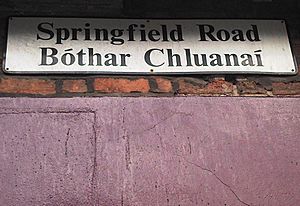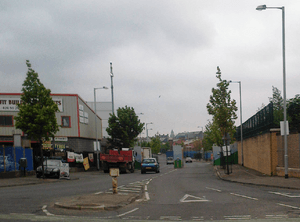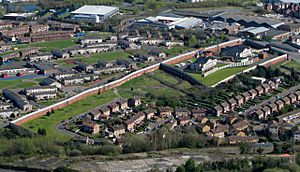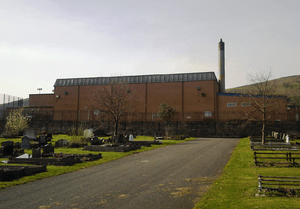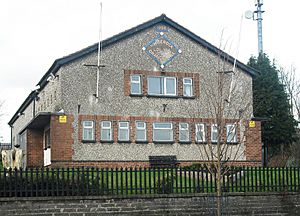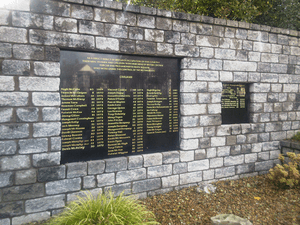Springfield Road facts for kids
The Springfield Road (Irish: Bóthar Chluanaí) is a busy road and neighborhood in west Belfast. It's next to the Falls Road. Most people living here are Irish nationalist and republican. Along parts of the road, there are places where this community meets the nearby loyalist areas of the Greater Shankill. The Springfield Road includes the Ballymurphy and New Barnsley areas. It is also overlooked by Black Mountain and Divis.
Contents
History of Springfield Road
A long time ago, much of the land where Springfield Road's houses now stand was countryside. It was near the bottom of the mountains. The area that became New Barnsley was called Brown's Fields. It was used for cows to graze. Later, factories came to the area. A textile factory called James Mackie & Sons opened on the road in the late 1800s. It became a big employer and made many supplies during the Second World War.
More houses were built in the 1940s. New housing estates were created. People were still separated by their religious backgrounds, which was common in Northern Ireland. The Highfield and New Barnsley estates were mostly for Protestant families. The Ballymurphy estate was mainly for Catholic families. In the 1960s, some people from the lower Falls area moved temporarily to Ballymurphy. This happened while new flats were being built. A young Gerry Adams, who later became a well-known politician, was one of those who moved.
Areas Along Springfield Road
The Springfield Road starts near the lower Falls Road. It continues from the Grosvenor Road, which connects the Falls to Belfast city centre. The road goes north-west, then sharply turns south-west. It eventually joins the Monagh by-pass. This bypass connects the area to Kennedy Way and the M1 motorway. Part of the road is called the B38, and another part is the A55.
Lower Springfield
The areas at the start of Springfield Road have many social housing estates. There are also some shops on the main road. These areas are part of the Edenderry and Clonard districts, which are also near the Falls Road. Because this area is close to loyalist estates, there are several "peace lines." These are barriers built to prevent conflict and damage. For example, Ainsworth Avenue, which used to connect Springfield Road to Woodvale Road, is now closed. Other streets like Kirk Street and Workman Avenue are also closed where they meet Springfield Road.
However, you can still get through Lanark Way. This street connects the Springfield and Shankill roads. It has gates that can be locked for safety. Other important places here include Springvale Industrial Estate and Business Park. There is also Springfield Park, a small park run by Belfast City Council. The Farset International centre, which offers budget accommodation and conferences, is inside Springfield Park. Clonard Monastery is also very close to Springfield Road.
Highfield and New Barnsley
The loyalist Highfield estate is next to Springfield Road, near West Circular Road. This area provides a way to get to Ballygomartin Road. Ballygomartin Road is mostly a Protestant area that connects to the Shankill Road. Near West Circular Road on Springfield Road is the Whiterock Orange Hall. Parades from this hall sometimes pass Catholic homes. This has caused tension and protests since the 1970s. In 2005, the hall was damaged in a fire.
The houses next to Highfield are called New Barnsley. This name came from a small group of houses that were burned down during the Troubles. A large peace line separates New Barnsley from the Highfield estate. This barrier runs along Springmartin Road. The New Barnsley Police Service of Northern Ireland station is at the Springfield Road end of this peace line. It is the main police station on the road. The old Springfield Road RUC station closed in 2002.
Ballymurphy and Whiterock
The area between Springfield Road and Whiterock Road is often called Ballymurphy. This is because of Ballymurphy Road. Springhill and Glenalina are also part of this area. The first houses in Ballymurphy were built in 1947. The council built 600 concrete houses to help with the city's growing population. The area is bordered by Whiterock Road. This road connects the Falls Road with the Ballygomartin Road and crosses Springfield Road at Ballymurphy. The Whiterock area is older than Ballymurphy, dating back to the 1920s.
Springhill Millennium Park is a public park in this area. Belfast City Cemetery is also located in the Whiterock area. Whiterock Leisure Centre is on Whiterock Road. In 1984, there was an incident there. After an Irish tricolour flag was put up, a politician named George Seawright led a group to remove it. Because of the high levels of poverty in the area, Mother Teresa started a religious mission in Ballymurphy in 1971. She lived there for about a year.
Turf Lodge
Another housing estate, Turf Lodge, is beyond Springfield Road. It is located between Whiterock Road, the Monagh Bypass, and Glen Road. This area was built in the late 1950s. It was made to house people from the crowded parts of the lower Falls. The area used to be a farm called Turf Lodge Farm, so the name was kept. Many of the first houses were not very good, especially the blocks of flats. After local women campaigned in the 1970s, some of the worst houses were taken down and rebuilt.
Education on Springfield Road
St Clare's Primary School is on the lower part of the road. It was built in 2005 by combining two older schools. Springfield Primary School, further along the road, has been there since 1910. There are no secondary schools directly on Springfield Road. However, there are several on the nearby Falls Road. Gort Na Móna Secondary School was on the road from 1971 to 1988. It closed after joining with other Catholic schools to form Corpus Christi College.
A branch of Belfast Metropolitan College is on the nearby Whiterock Road. St Gerard's Education Resource Centre, a special school, is on Belfield Heights. This is near where Springfield Road joins the Monagh By-pass.
Sports in the Area
Gort na Mona GAC is a Gaelic Athletic Association club. It started in the Turf Lodge area of west Belfast. Their main building is now on Springfield Road. Lámh Dhearg GAC is another club based in the area, on Hannahstown Hill.
The football club Iveagh United F.C. was formed here in the early 1960s. They play in the Northern Amateur Football League. However, they have since moved and are now based in the Twinbrook area of Dunmurry.
Holy Trinity Boxing Club is located in Turf Lodge. It is well-known for its success in amateur boxing. Many champions of different ages have trained there. Damaen Kelly, a famous boxer who won two bronze medals as an amateur and was a triple weight champion as a professional, trained at this club.
Transport and Travel
The small group of cottages that made up the New Barnsley area used to be the end point for public transport. Buses would not go any further. However, Springfield Road is no longer one of the main routes for Translink. Translink provides the Metro bus service in Belfast. The road is now only served by the less frequent 80 and 81 bus services.
Both Springfield Road and the western parts of Belfast often had a lot of traffic. So, in 1978, the Monagh Bypass was opened near Springfield Road. This was meant to provide another route for cars. However, the bypass is not fully finished. It was found that much of the land near the mountains was difficult to build on. Because of this, traffic jams are still a problem. After the Bypass, the Upper Springfield Road becomes the B38. This is a smaller road that connects Belfast with the village of Glenavy.
The Troubles and Springfield Road
Streets leading off Springfield Road were at the center of the 1969 riots. These were some of the first major events during the period known as the Troubles. The Troubles was a time of conflict in Northern Ireland. Kashmir Road, which is off lower Springfield Road, saw homes attacked. This also happened on Cupar Street and Bombay Street, which are between the Springfield, Falls, and Shankill Roads.
Protests and clashes returned the next year. There was fierce fighting where Catholic Ballymurphy and the then-Protestant New Barnsley areas met. On March 31, 1970, junior Orange Order bands were going to Bangor, County Down. They played their music on Springfield Road early in the morning. Even though the bands left without problems, angry residents gathered in Ballymurphy. Soldiers from the Scots Guards were sent to prepare for trouble later that night. When the bands returned, clashes broke out between the groups. This quickly turned into a large protest. Soldiers struggled to keep order. More soldiers were sent to Ballymurphy the next night. In anger, residents protested against the soldiers. Three nights of protests followed. The army used tear gas to try to break up the crowds. The Protestant people of New Barnsley moved out of the area soon after this.
A very sad event in the road's history was the Ballymurphy Massacre. This was when eleven civilians died on the road between August 9 and 11, 1971. This happened during a military operation. Members of the Parachute Regiment of the British Army were involved. They said they were only shooting back after being shot at. However, the families of the victims have been working for a long time. They want the British government to admit that their relatives were not involved in any attacks on soldiers. The Springhill Massacre, which happened in 1972, also involved soldiers killing civilians on Springfield Road.
Springfield Road has long been a strong area for the Provisional Irish Republican Army (IRA). After a split in the Irish Republican Army in 1969, the Ballymurphy unit was one of the first to support the Provisional IRA. The Royal Ulster Constabulary (RUC) police station on the road was also used by the British Army. This made the road an important place in the conflict between the British military and Irish republican groups.
One event happened on May 25, 1971. A bomb was thrown into the base. An army Sergeant named Michael Willetts died as he protected civilians from the blast with his body. He was given a special award called the George Cross. Seven RUC officers, two British soldiers, and 18 civilians were hurt. The IRA attacked the barracks again on January 1, 1973, hurting two people. On October 28, 1979, a soldier and a policeman were killed in a machine gun attack on the barracks. On September 20, 1982, a British soldier was killed when the IRA fired a rocket at his observation post at the barracks. On May 2, 1987, an IRA volunteer died when a bomb exploded too early during an attack on the base. Another attack happened on September 20, 1987, with no injuries. The base was attacked again on December 27, 1993. The IRA ended their Christmas break with several attacks on RUC and army bases, including a car bomb outside Springfield Road station. The last attack happened on August 30, 1994. The base was bombed at the same time as another attack on the nearby Whiterock army base.
Other IRA attacks on Springfield Road included a British soldier being killed by a sniper on April 8, 1972. A civilian died in a car bomb on March 26, 1974. Another soldier died on June 30, 1976. On May 14, 1981, an RUC officer was killed when his patrol vehicle was hit by an IRA rocket on Springfield Road. On October 14, 1982, a bomb attack happened on an army patrol in Ballymurphy. One of the deadliest IRA attacks in the area happened on March 25, 1982. Three British soldiers were killed and five other people were hurt in a gun attack on Crocus Street, off Springfield Road. An Ulster Defence Regiment soldier was also killed on the road by the Irish National Liberation Army on September 29, 1981.
Loyalist groups also targeted people living in the area during the Troubles. The UDA, which first said it was protecting Protestant communities, put up temporary barriers on Ainsworth Avenue. These blocked the way between the Shankill and Springfield roads. These barriers later became permanent peace lines. On September 13, 1972, the UDA opened fire inside a Catholic-owned bar on Springfield Road, killing the owner's son. On September 5, 1973, the UDA claimed responsibility for a car bomb that caused a lot of damage but no deaths after the area was cleared. Later that year, they shot and killed a Catholic person outside their workplace on the road. This was followed on November 22, 1974, by the killing of a Catholic woman at her workplace on Springfield Road. On October 9, 1987, Francisco Notarantonio, a 66-year-old man who had been held in 1971 but had not been active for over 40 years, was shot dead at his home in Ballymurphy. The UDA mostly stopped activities in Springfield Road until the 1990s. Then, they claimed three separate civilian killings on September 3, 1991, April 28, 1992, and April 27, 1994.
The Ulster Volunteer Force (UVF) also carried out killings on Springfield Road during the Troubles. On May 28, 1972, they shot and killed a Catholic civilian on the road. Another was killed in Whiterock Gardens on February 4, 1974. On April 9, 1976, they exploded a bomb at Divis Castle Bar, killing another Catholic civilian. Another Catholic civilian was killed at his home on September 12, 1979, and again in the same way on June 25, 1987. On March 10, 1989, a security guard was killed outside the Orient Bar. On June 26, 1993, loyalists protested when the RUC stopped an Orange Order march near a peace line in the area. On Ainsworth Avenue, a UVF member was hurt when a grenade he was holding exploded too early. Eighteen people were injured. He died three days later.


